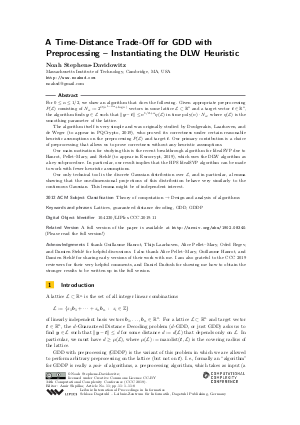A Time-Distance Trade-Off for GDD with Preprocessing - Instantiating the DLW Heuristic
Author Noah Stephens-Davidowitz
-
Part of:
Volume:
34th Computational Complexity Conference (CCC 2019)
Part of: Series: Leibniz International Proceedings in Informatics (LIPIcs)
Part of: Conference: Computational Complexity Conference (CCC) - License:
 Creative Commons Attribution 3.0 Unported license
Creative Commons Attribution 3.0 Unported license
- Publication Date: 2019-07-16
File

PDF
LIPIcs.CCC.2019.11.pdf
- Filesize: 445 kB
- 8 pages
Document Identifiers
Related Versions
-
A full version of the paper is available at http://arxiv.org/abs/1902.08340. (Please read the full version!)
Subject Classification
ACM Subject Classification
- Theory of computation → Design and analysis of algorithms
Keywords
- Lattices
- guaranteed distance decoding
- GDD
- GDDP
Metrics
- Access Statistics
-
Total Accesses (updated on a weekly basis)
0Document
0Metadata
Abstract
For 0 <= alpha <= 1/2, we show an algorithm that does the following. Given appropriate preprocessing P(L) consisting of N_alpha := 2^{O(n^{1-2 alpha} + log n)} vectors in some lattice L subset {R}^n and a target vector t in R^n, the algorithm finds y in L such that ||y-t|| <= n^{1/2 + alpha} eta(L) in time poly(n) * N_alpha, where eta(L) is the smoothing parameter of the lattice.
The algorithm itself is very simple and was originally studied by Doulgerakis, Laarhoven, and de Weger (to appear in PQCrypto, 2019), who proved its correctness under certain reasonable heuristic assumptions on the preprocessing P(L) and target t. Our primary contribution is a choice of preprocessing that allows us to prove correctness without any heuristic assumptions.
Our main motivation for studying this is the recent breakthrough algorithm for IdealSVP due to Hanrot, Pellet - Mary, and Stehlé (to appear in Eurocrypt, 2019), which uses the DLW algorithm as a key subprocedure. In particular, our result implies that the HPS IdealSVP algorithm can be made to work with fewer heuristic assumptions.
Our only technical tool is the discrete Gaussian distribution over L, and in particular, a lemma showing that the one-dimensional projections of this distribution behave very similarly to the continuous Gaussian. This lemma might be of independent interest.
Cite As Get BibTex
Noah Stephens-Davidowitz. A Time-Distance Trade-Off for GDD with Preprocessing - Instantiating the DLW Heuristic. In 34th Computational Complexity Conference (CCC 2019). Leibniz International Proceedings in Informatics (LIPIcs), Volume 137, pp. 11:1-11:8, Schloss Dagstuhl – Leibniz-Zentrum für Informatik (2019)
https://doi.org/10.4230/LIPIcs.CCC.2019.11
BibTex
@InProceedings{stephensdavidowitz:LIPIcs.CCC.2019.11,
author = {Stephens-Davidowitz, Noah},
title = {{A Time-Distance Trade-Off for GDD with Preprocessing - Instantiating the DLW Heuristic}},
booktitle = {34th Computational Complexity Conference (CCC 2019)},
pages = {11:1--11:8},
series = {Leibniz International Proceedings in Informatics (LIPIcs)},
ISBN = {978-3-95977-116-0},
ISSN = {1868-8969},
year = {2019},
volume = {137},
editor = {Shpilka, Amir},
publisher = {Schloss Dagstuhl -- Leibniz-Zentrum f{\"u}r Informatik},
address = {Dagstuhl, Germany},
URL = {https://drops.dagstuhl.de/entities/document/10.4230/LIPIcs.CCC.2019.11},
URN = {urn:nbn:de:0030-drops-108331},
doi = {10.4230/LIPIcs.CCC.2019.11},
annote = {Keywords: Lattices, guaranteed distance decoding, GDD, GDDP}
}
Author Details
Acknowledgements
I thank Guillaume Hanrot, Thijs Laarhoven, Alice Pellet - Mary, Oded Regev, and Damien Stehlé for helpful discussions. I also thank Alice Pellet - Mary, Guillaume Hanrot, and Damien Stehlé for sharing early versions of their work with me. I am also grateful to the CCC 2019 reviewers for their very helpful comments, and Daniel Dadush for showing me how to obtain the stronger results to be written up in the full version.
References
- Divesh Aggarwal, Daniel Dadush, Oded Regev, and Noah Stephens-Davidowitz. Solving the Shortest Vector Problem in 2ⁿ time via Discrete Gaussian Sampling. In STOC, 2015. URL: http://arxiv.org/abs/abs/1412.7994.
- Divesh Aggarwal, Daniel Dadush, and Noah Stephens-Davidowitz. Solving the Closest Vector Problem in 2ⁿ time-The discrete Gaussian strikes again! In FOCS, 2015. URL: http://arxiv.org/abs/1504.01995.
-
L. Babai. On Lovász' lattice reduction and the nearest lattice point problem. Combinatorica, 6(1), 1986.

-
Wojciech Banaszczyk. New bounds in some transference theorems in the geometry of numbers. Mathematische Annalen, 296(4), 1993.

-
Wojciech Banaszczyk. Inequalites for convex bodies and polar reciprocal lattices in ℝⁿ. Discrete & Computational Geometry, 13, 1995.

- Daniel Dadush, Oded Regev, and Noah Stephens-Davidowitz. On the Closest Vector Problem with a distance guarantee. In CCC, 2014. URL: http://arxiv.org/abs/1409.8063.
- Emmanouil Doulgerakis, Thijs Laarhoven, and Benne de de Weger. Finding closest lattice vectors using approximate Voronoi cells. In PQCrypto, 2019. (To appear.) URL: https://eprint.iacr.org/2016/888.
-
Nicolas Gama and Phong Q. Nguyen. Finding Short Lattice Vectors Within Mordell’s Inequality. In STOC, 2008.

-
Ishay Haviv, Vadim Lyubashevsky, and Oded Regev. A Note on the Distribution of the Distance from a Lattice. Discrete & Computational Geometry, 41(1), 2009.

- Thijs Laarhoven. Finding closest lattice vectors using approximate Voronoi cells, 2016. URL: https://eprint.iacr.org/2016/888/20161219:141310.
-
Thijs Laarhoven. Sieving for Closest Lattice Vectors (with Preprocessing). In SAC, 2016.

-
Yi-Kai Liu, Vadim Lyubashevsky, and Daniele Micciancio. On Bounded Distance Decoding for general lattices. In RANDOM, 2006.

-
J. E. Mazo and A. M. Odlyzko. Lattice points in high-dimensional spheres. Monatshefte für Mathematik, 110(1), 1990.

- Daniele Micciancio and Chris Peikert. Trapdoors for Lattices: Simpler, Tighter, Faster, Smaller. In EUROCRYPT, 2012. URL: https://eprint.iacr.org/2011/501.
-
Daniele Micciancio and Oded Regev. Worst-case to average-case reductions based on Gaussian measures. SIAM Journal of Computing, 37(1), 2007.

-
Daniele Micciancio and Panagiotis Voulgaris. A deterministic single exponential time algorithm for most lattice problems based on Voronoi cell computations. SIAM Journal on Computing, 42(3), 2013.

-
Chris Peikert. Limits on the Hardness of Lattice Problems in 𝓁_p Norms. Computational Complexity, 17(2), 2008.

-
Alice Pellet-Mary, Guillaume Hanrot, and Damien Stehlé. Approx-SVP in Ideal Lattices with Pre-processing. In Eurocrypt, 2019. (to appear).

-
Claus-Peter Schnorr. A Hierarchy of Polynomial Time Lattice Basis Reduction Algorithms. Theor. Comput. Sci., 53(23), 1987.

-
Noah Stephens-Davidowitz. On the Gaussian measure over lattices. Ph.D. thesis, New York University, 2017.

- Noah Stephens-Davidowitz. A time-distance trade-off for GDD with preprocessing - Instantiating the DLW heuristic, 2019. URL: http://arxiv.org/abs/1902.08340.
-
Roman Vershynin. Introduction to the non-asymptotic analysis of random matrices. In Compressed Sensing: Theory and Applications. Cambridge University Press, 2012.

